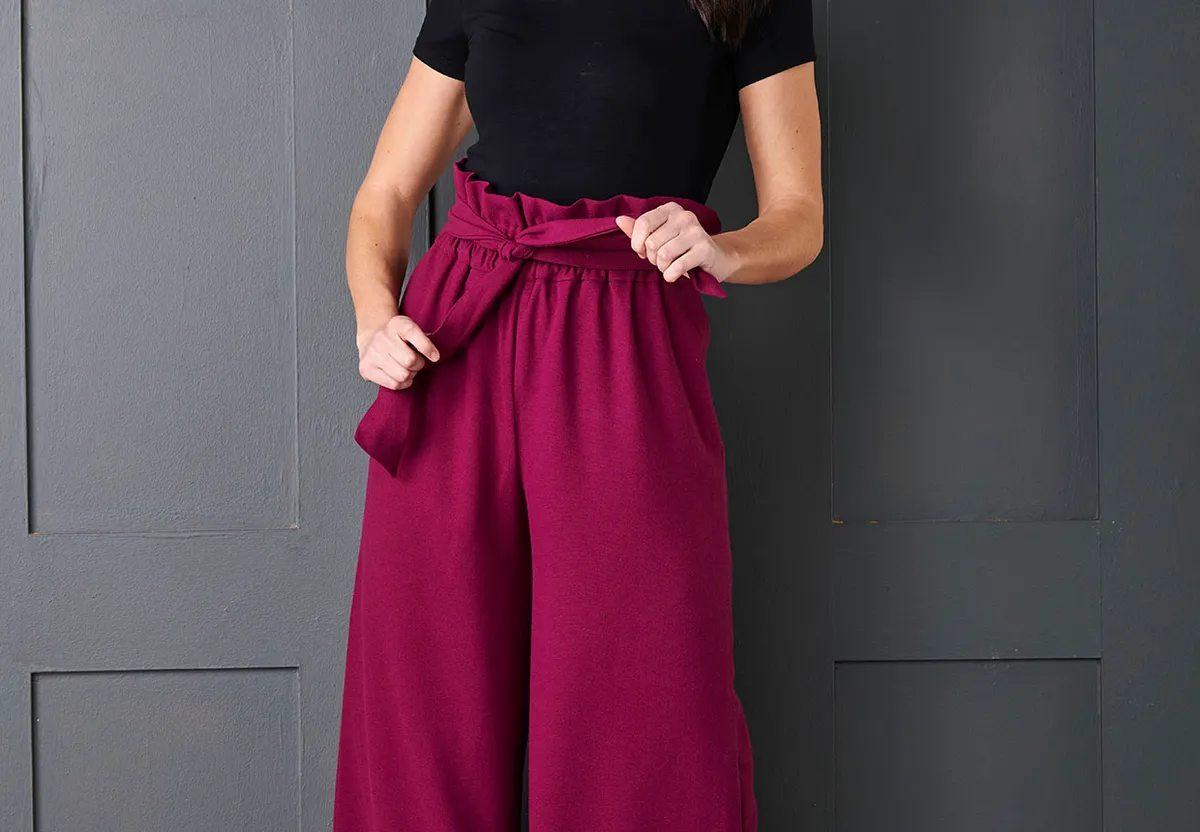How to make a circle skirt
Get ready to celebrate the festive season in style with this beautiful circle skirt sewing pattern! If you're not a fan of faux leather, then you can use any medium-weight fabric to make this pattern.
You don't need to download any patterns or templates to craft this stunning skirt – it's made to measure, so it's guaranteed to be a perfect fit.
Read on to discover how to make a circle skirt…
How to make a circle skirt: step by step
You will need:
- Main fabric (see instructions for measurements) (3.5m (4yds))
- Contrast fabric for waistband facing (optional, see instructions for measurements)
- Zip (20cm (8in))
- Water-erasable fabric marker
- Teflon presser foot (if using faux leather fabric)
- Scotch tape
Taking your measurements
Step 1
Before starting, you will need to establish your waist measurement (W) and then perform the following calculations. These instructions are to make a ¾ circle skirt. The calculations would be different for full, half or quarter circle skirts.
- W = waist
- C = circumference
- D = diameter
- R = radius
- QC = quarter circle
W x 1.33 = C (make a note of this number) then C ÷ 3.1415356592 (π) = D then D ÷ 2 = R (make a note of this number) then W ÷ 4 = QC (a quarter of your desired finished waist measurement).
Creating the pattern
Step 1
Using a long ruler, draw a straight line on your pattern paper. ‘Fan’ the ruler out, using the start of your first line as a pivot point, and draw several more lines to create the fan shape.

Step 2
Along each of your drawn lines, mark a measurement from the pivot point that is equal to R which you made a note of earlier.
Step 3
Join the dots up with a curved line – this will form the waistline curve. Mark out a section on this curved line that measures the same as your QC number and erase any lines that fall beyond this measurement.
What’s left will form the basis of your skirt pattern piece and represents one quarter of the finished garment.

Step 4
Measuring from the waistline curve, along each line mark a point equal to the desired finished length of the skirt.
For a knee-length skirt, measure from your waist to your knee and use this as your measurement. Because of the nature of circle skirts and the limitations of the width of fabric available, the maximum length of your skirt will be dictated by the width of the fabric.

Step 5
Join the marked points with a smooth curved line. This is the hemline of your skirt.
Step 6
Trace this pattern piece onto a new sheet of paper and add 1cm (3⁄8in) seam allowance to the waistline curve and straight sides.
Step 7
If your fabric requires you to hem the skirt, then add a hem allowance to the hemline curve. Because of the nature of the fabric we are using, we chose to leave the hem edge raw, so did not add a hem allowance.

Cutting out
Step 1
Fold the main fabric in half top to bottom, not left to right as you normally would, with the right sides (RS) together and with the selvedges aligned.
Step 2
Cut the front section of the skirt in one piece. To do this, place one of the straight edges of the pattern piece along the folded top edge of the fabric. But allow the seam allowance to overhang the folded edge as pictured. This eliminates the centre front (CF) seam.
Step 3
The back section of the skirt is cut in two pieces as there will be a zip in the centre-back (CB) seam. Cut two of the pattern pieces, including all seam allowances, from the remainder of the fabric. Make sure you retain a strip of fabric for the waistband in the next step.
Step 4
For the waistband, cut a strip of fabric 7cm (23⁄4in) wide and equal to the circumference of your waist line.
Step 5
For the waistband facing, cut a strip of contrast fabric or main fabric the same width as your waistband, and 3cm (11⁄4in) longer.
Making the waistband
Step 1
Staystitch the curved edges of the waistband within the 1cm (3⁄8in) seam allowance.
Step 2
Sew the back pieces to the front skirt piece with RS together, raw edges aligned and with a 1cm (3⁄8in) seam allowance.
Step 3
Press the seams open and flat and then to the side. Note that with faux leather fabric, any pressing must be done through a cloth when pressing the RS of the fabric.
Step 4
From the RS, topstitch the seam allowance down, approx 2mm (1⁄8in) from the seam line.
Step 5
With RS together, pin the waistband to the waistline curve. If using faux leather fabric, pin within the seam allowance to avoid leaving visible pin holes on the finished garment, or use fabric clips to hold it in place.
Step 6
Sew the waistband to the waistline curve using a 1cm (3⁄8in) seam allowance. Press this seam up and away from the garment and understitch close to the seam line.
Making up the skirt
Step 1
With the RS together, sew up the CB seam, including the waistband in one pass. Start stitching from the top of the seam, and for 20cm (8in) tack with the longest stitch on your machine, then switch to a standard stitch length, backstitch a few times and continue sewing the rest of the seam to the hem.
Step 2
Press the seam open and flat.
Inserting the zip
Step 1
Remove the tacking stitches from the top 20cm (8in) of the CB seam.
Step 2
You can opt for a standard centred zip, an invisible zip or, as we have done, an exposed zip. An exposed zip means that we didn’t have to stitch right up close to the zip teeth, so we could use a Teflon presser foot.
Step 3
Instead of pinning and tacking the zip into place, which could damage the faux leather fabric, we used scotch tape to hold it in place.
Step 4
Topstitch all the way around the zip.
Facing the waistband
Step 1
Take the waistband facing and press 1cm (3⁄8in) seam allowance to the WS along one edge. Pin the other raw edge, RS together to the raw edge of your waistband.
Step 2
It will overlap your zipper teeth by 1.5cm (5⁄8in) either side. Sew together, using a 1cm (3⁄8in) seam allowance. Press the facing up and away from the waistband and understitch close to the seam line.
Step 3
Roll and press the facing to the inside of the waistband. You could also understitch the fold into place, as pressing alone may not provide the crisp edge required.
Step 4
Press under the 1.5cm (5⁄8in) seam allowance along the short edges of the facing so they are away from the zipper teeth on the inside.
Step 5
Slipstitch the folded edge of the facing in place to complete.
Finishing the skirt
Step 1
Hang the skirt overnight, as circle skirt hems can drop as the fabric stretches due to gravity, and then even out the hem if needed by cutting it parallel to the floor whilst it is hanging.
Step 2
If desired, hem the skirt by turning the hem allowance over to the wrong side (WS) and pressing in place, then turn over and press once more to hide all raw edges. Topstitch in place.
You’re all done! Enjoy wearing your wonderful new circle skirt!

Create a circle skirt for every occasion
Perfect for evening events or wearing to work, this circle skirt will become a new staple in your wardrobe. Use the pattern to sew skirts in a range of different materials, including wintery wools and summery linens.
Make a statement with our wide leg pants pattern
Now it's time for trousers! Use our wide leg pants pattern to stitch your own.



